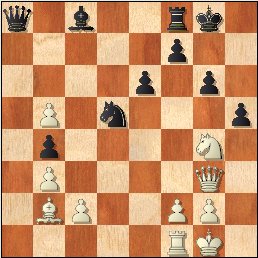

Monthly Special $$ offers - FREE books and Savings
Improve your Chess via Active Learning
ACTIVE LEARNING is any strategy that involves students in doing things and thinking about the things they are doing (*)
You could study the following material either by skipping the test and going directly to the lecture. Or start by attempting to figure out on your own what is going on in each of the positions I will be talking about and then proceed to the lecture. If you chose the latter, spend time on each diagram and record your evaluation and move / plan for the side whose turn it is and sample variations. Then compare your ideas with mine. Let me know how you like the test and the lecture
Test yourself:
Level - beginner through advanced.
1. Check whose move it is / Read the question.
2. Evaluate position (i.e. White is Better, or Black is Winning, or Equal...)
3. Find the Best move and, if necessary, support it with variations. <<CALCULATE thoroughly!!>>
4. Answer the question (if there is a specific one)
What do you think about trade of the Ns in the following positions?
 |
 |
| #1. 50...Ng3+ | #2. 21.Nf6+ |
STOP - the lecture begins below.
A Bad Trade? Not Exactly! Very Unusual Variation of the Common Tactical Theme
This article was originally published on the website http://www.chess.com/ in May 2009.
I'd like to show a very unusual variation of the very important tactical theme - Intermediate Move (also called In-between Move, Zwischenzug).
| A typical
Intermediate Move occurs when a Player A either captures a
piece or a pawn, or creates a threat, but the player B, rather then
addressing the issue, creates a counter-threat of at least an
equal strength (often a check). Only when the Player A addresses the
threat, the player B deals with the original issue (either recaptures or
defends).
Example: Letov,Alexander - Khamatgaleev,Alexej, Russia 1997. Black to Move 1...Rd8! 2.Qxb6 Rxd1+ (Intermediate move) 3.Kf2 Pxb6 -+, winning the R |
 |
Once you learn this standard theme and solved enough problems, you will be able to execute this idea in your games.
Here, I wanted to present you with a very unusual variation of an Intermediate Move. Indeed, rather then re-capturing the N, which in both examples would result in far less than optimal position, a different move was played with the attack on the N that was already available to be captured! This is what was so unusual and perhaps stumped many who tried to evaluate the check with the N.
|
Diagram #1
Do you like 50...Ng3+? |
Alekseev,Evgeny - Jakovenko,Dmitrij, Sochi, Russian Teams 2009
White has an excellent chances to escape due to the Bs of opposite color. The trade of the Ns seems only helpful to his cause. After 51. Nxg3 Bxg3 52.Bg2 then Ke3-e2, the Black K will never reach the g1-square. Black also has no chance on the Q-side (the a4-P is easily defended with the B).
This basic conclusion is proven incorrect an after an amazing 51...Kh4!!, attacking the N (rather than simply taking it) and the B. The difference of course is that by capturing the N with the K, Black will be able to get his K to g1 and promote the h-P. I.e. 52.Bg2 Kxg3 53.Bh1 Kf2-+.
Instead, White gave up the B, but soon succumbed to zugzwang... 52.Kf3 Kxh3 53.Nh1 Bb6-+ 54.Ng3 0-1 [White resigned in view of 54... Bd8 55.Nh1 Bh4 56.Ke2 Kg2] |
|
Diagram #2
Do you like 21.Nf6+? |
Efimenko,Zahar - Ivanov,S, Russia 2009
Black has 'holes' around his K and no B on g7 to cover them. The White B is a dominant force along the dark-squares. However, trading the last defender (d5-N) after 21.Nf6+ Nxf6 22.Bxf6 +/- doesn't seem very promising. Black could bring his Q up (22...Qd5 or 22...Qe4) to prevent invasion Qg3-f4(g5)-h6. White has advantage, but Black is alive.
Again, fortunately for White, he could postpone capture on f6 and instead... attack the poor N yet again - 22.Qe5!+- Black is hopeless and resigned after 22...Re8 23.Qxf6 e5 [23...Kf8 24.Bc1+- aiming at h6] 24.Bxe5 Rxe5 25.Qxe5 Bb7 26.Re1 Kh7 27.Qe8 1-0 |
Summary:
I wanted to show this rare variation of one of the key tactical theme - attacking the piece you could have captured for free. Hopefully, this was enjoyable and educational and you will add this tactical pattern to your knowledge base.
==============================================================================================
What do you think about this article? How did you do? For comments,
corrections send email or use
this
form
More on chess training (serious and enlightening) in my books:
|
|
Chess Exam and Training Guide (2004) $24.95 + shipping Chess Exam and Training Guide: Tactics (2007) $19.95 + shipping CE + CE Tactics (Holiday Special! Free chess cartoon calendar $8, while supplies last) - $39.95 - insured shipping in US is included |
Copyrighted @ 2009 Igor Khmelnitsky
For comments or permission to reprint please send inquires via email or this form
(*Bonwell, C., & Eison, J. (1991). Active learning: Creating excitement in the classroom (ASHE-ERIC Higher Education Report No. 1). Washington, DC: George Washington University, p. 2)